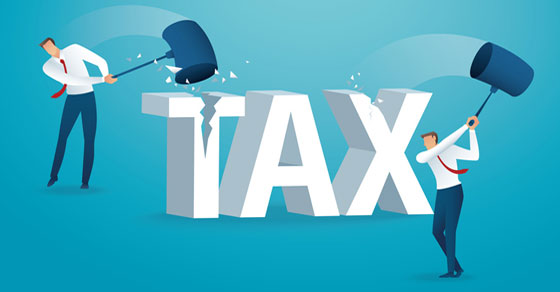4 min read
Tax Provisions of CARES Act for Businesses – April 1, 2020 Update
 TMA Accounting
:
April 04, 2020
TMA Accounting
:
April 04, 2020

Employee retention credit for employers
Eligible employers can qualify for a refundable credit against, generally, the employer’s 6.2% portion of the Social Security (OASDI) payroll tax (or against the Railroad Retirement tax) for 50% of certain wages (below) paid to employees during the COVID-19 crisis.
The credit is available to employers carrying on business during 2020, including non-profits (but not government entities), whose operations for a calendar quarter have been fully or partially suspended as a result of a government order limiting commerce, travel or group meetings. The credit is also available to employers who have experienced a more than 50% reduction in quarterly receipts, measured on a year-over-year basis relative to the corresponding 2019 quarter, with the eligible quarters continuing until the quarter after there is a quarter in which receipts are greater than 80% of the receipts for the corresponding 2019 quarter.
For employers with more than 100 employees in 2019, the eligible wages are wages of employees who aren’t providing services because of the business suspension or reduction in gross receipts described above.
For employers with 100 or fewer full-time employees in 2019, all employee wages are eligible, even if employees haven’t been prevented from providing services. The credit is provided for wages and compensation, including health benefits, and is provided for the first $10,000 in eligible wages and compensation paid by the employer to an employee. Thus, the credit is a maximum $5,000 per employee.
Wages don’t include (1) wages taken into account for purposes of the payroll credits provided by the earlier Families First Coronavirus Response Act for required paid sick leave or required paid family leave, (2) wages taken into account for the employer income tax credit for paid family and medical leave (under Code Sec. 45S) or (3) wages in a period in which an employer is allowed for an employee a work opportunity credit (under Code Sec. 51). An employer can elect to not have the credit apply on a quarter-by-quarter basis.
The IRS has authority to advance payments to eligible employers and to waive penalties for employers who do not deposit applicable payroll taxes in reasonable anticipation of receiving the credit. The credit is not available to employers receiving Small Business Interruption Loans. The credit is provided for wages paid after March 12, 2020, through December 31, 2020.
Delayed payment of employer payroll taxes
Taxpayers (including self-employeds) will be able to defer paying the employer portion of certain payroll taxes through the end of 2020, with all 2020 deferred amounts due in two equal installments, one at the end of 2021, the other at the end of 2022. Taxes that can be deferred include the 6.2% employer portion of the Social Security (OASDI) payroll tax and the employer and employee representative portion of Railroad Retirement taxes (that are attributable to the employer 6.2% Social Security (OASDI) rate). The relief isn’t available if the taxpayer has had debt forgiveness under the CARES Act for certain loans under the Small Business Act as modified by the CARES Act (see below). For self-employeds, the deferral applies to 50% of the Self-Employment Contributions Act tax liability (including any related estimated tax liability).
Accelerated payment of credits for required paid sick leave and family leave
The CARES Act authorizes IRS broadly to allow employers an accelerated benefit of the paid sick leave and paid family leave credits allowed by the Families First Coronavirus Response Act by, for example, not requiring deposits of payroll taxes in the amount of credits earned.
Pension funding delay
The CARES Act gives single employer pension plan companies more time to meet their funding obligations by delaying the due date for any contribution otherwise due during 2020 until January 1, 2021. At that time, contributions due earlier will be due with interest. Also, a plan can treat its status for benefit restrictions as of December 31, 2019, as applying throughout 2020.
Certain SBA loan debt forgiveness isn’t taxable
Amounts of Small Business Administration Section 7(a)(36) guaranteed loans that are forgiven under the CARES Act aren’t taxable as discharge of indebtedness income if the forgiven amounts are used for one of several permitted purposes. The loans have to be made during the period beginning on February 15, 2020, and ending on June 30, 2020.
Net operating loss liberalizations
The 2017 Tax Cuts and Jobs Act (the 2017 Tax Law) limited NOLs arising after 2017 to 80% of taxable income and eliminated the ability to carry NOLs back to prior tax years. For NOLs arising in tax years beginning before 2021, the CARES Act allows taxpayers to carryback 100% of NOLs to the prior five tax years, effectively delaying for carrybacks the 80% taxable income limitation and carryback prohibition until 2021.
The Act also temporarily liberalizes the treatment of NOL carryforwards. For tax years beginning before 2021, taxpayers can take an NOL deduction equal to 100% of taxable income (rather than the present 80% limit). For tax years beginning after 2021, taxpayers will be eligible for: (1) a 100% deduction of NOLs arising in tax years before 2018, and (2) a deduction limited to 80% of taxable income for NOLs arising in tax years after 2017.
The provision also includes special rules for REITS, life insurance companies, and the Code Sec. 965 transition tax. There are also technical corrections to the 2017 Tax Law effective dates for NOL changes.
Relaxation of business interest deduction limit
The 2017 Tax Law generally limited the amount of business interest allowed as a deduction to 30% of adjusted taxable income (ATI). The CARES Act generally allows businesses, unless they elect otherwise, to increase the interest limitation to 50% of ATI for 2019 and 2020, and to elect to use 2019 ATI in calculating their 2020 limitation. For partnerships, the 30% of ATI limit remains in place for 2019 but is 50% for 2020. However, unless a partner elects otherwise, 50% of any business interest allocated to a partner in 2019 is deductible in 2020 and not subject to the 50% (formerly 30%) ATI limitation. The remaining 50% of excess business interest from 2019 allocated to the partner is subject to the ATI limitations. Partnerships, like other businesses, may elect to use 2019 partnership ATI in calculating their 2020 limitation.
Technical correction to restore faster write-offs for interior building improvements
The CARES Act makes a technical correction to the 2017 Tax Law that retroactively treats (1) a wide variety of interior, non-load-bearing building improvements (qualified improvement property (QIP)) as eligible for bonus deprecation (and hence a 100% write-off) or for treatment as 15-year MACRS property or (2) if required to be treated as alternative depreciation system property, as eligible for a write-off over 20 years. The correction of the error in the 2017 Tax Law restores the eligibility of QIP for bonus depreciation, and in giving QIP 15-year MACRS status, restores 15-year MACRS write-offs for many leasehold, restaurant and retail improvements.
IRS information website
Ongoing information on the IRS and tax legislation response to COVID- 19 can be found at https://www.irs.gov/coronavirus
As always, if you have any questions about this information, please feel free to reach out to us.
Disclaimer:Nothing in this post constitutes legal, tax or financial advice and is intended for informational and educational purposes only. This informational and educational material is not intended, and must not be taken, as legal, tax or financial advice on any particular set of facts or circumstances or as recommendations that are suitable for any specific person. You need to contact a lawyer, accountant or financial adviser licensed in your jurisdiction for advice on your specific questions, issues and concerns. View our full Terms of Use here.



